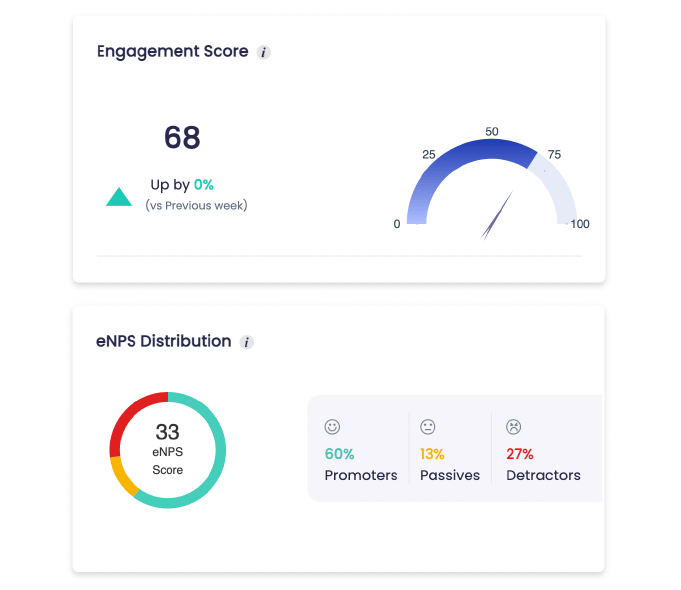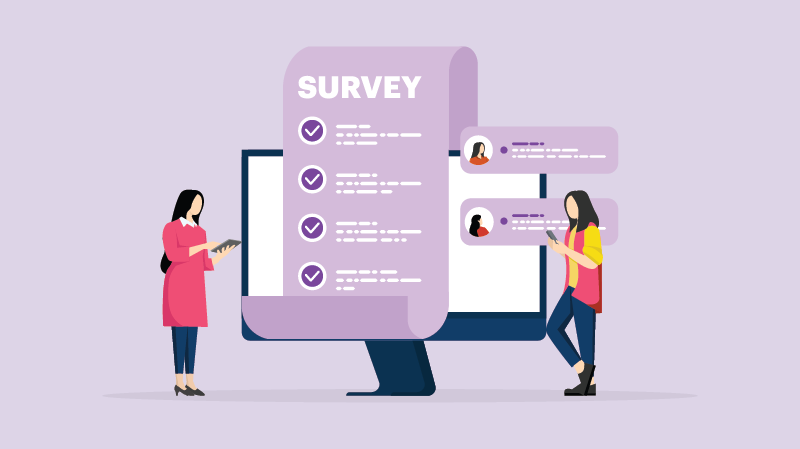Everything about Employee Pulse Survey in 2024
Pulse surveys are agile tools for collecting real-time employee feedback. These brief, frequent surveys help organizations gauge sentiment, address issues, and maintain responsiveness.
Recent trends involve:
- More frequent surveys.
- Remote work considerations.
- Well-being focus.
- AI and analytics usage.
- Actionable insights.
- Segmentation.
Pulse surveys closely correlate with employee engagement by enabling organizations to measure, adapt, and enhance engagement based on timely feedback.
Key Insights
- Concept of Pulse Surveys
- Objectives and Benefits of Pulse Surveys
- Steps to create a structure of Pulse Surveys
- Best Practices for Pulse Surveys
- Sample Questions for Pulse Surveys
What are Pulse Surveys?

Employee pulse surveys are a form of employee engagement survey used by organizations to assess the overall employee experience by gathering relevant employee feedback. It is a quick, trouble-free, and robust way to improve employee engagement by evaluating the company’s strengths and weaknesses through the survey results.
As the name suggests, a pulse survey is designed to track the organization’s “pulse or the heartbeat.” Just like our pulse rate gives a quick check of human health, an employee pulse survey measures the “health” of the company culture.

(Source: Vantage Pulse)
For the layman, pulse surveys are short, standardized, and focused. The employees receive a set of survey questions and have to rate them on a scale of 1-10.
The objective of a pulse survey is to quickly identify major concerns and areas of improvement within the organization.
Pulse surveys contain several short, simplified questions covering significant components of employee engagement. You can also add an optional comment section along with each question where they can elaborate on their answers.
They have become increasingly popular in modern companies due to their ease of use, management, and efficiency in collecting valuable company insights.
Objectives of Pulse Survey
- Employee Engagement: Measure and enhance employees' emotional commitment and enthusiasm for their work.
- Feedback Collection: Gather timely and relevant feedback from employees on various aspects of the organization.
- Performance Assessment: Assess employee satisfaction, morale, and overall performance more frequently.
- Organizational Alignment: Gauge the alignment of employees with the organization's values, mission, and goals.
- Well-being Check: Monitor and address employee well-being, stress levels, and work-life balance.
10 Amazing Benefits of Pulse Surveys

1. Real-Time Insights into Employee Experience
Conducting pulse surveys on a regular basis allows organizations to gain real-time insights into the employee experience. Unlike annual surveys, pulse surveys capture feedback at the moment, enabling issues to be identified as they occur rather than months later.
Trends and changes in satisfaction or engagement can be closely tracked over time rather than just having one data point per year. With real-time data, organizations can also monitor the impact of policy changes, tools, procedures, and more.
2. Spot and Address Issues Quickly
A major advantage of frequent pulse surveys is that problems and concerns can be spotted way before they escalate or spread.
For instance, a dip in engagement scores from one survey to the next could trigger further investigation through focus groups into the drivers. Root causes of issues can be addressed promptly through improved communication, training, workflow changes, and more.
By rapidly resolving issues identified through pulse surveys, organizations can prevent larger problems like widespread disengagement and turnover. Employees will see that action is being taken based on their feedback.
3. Reduce Survey Fatigue
Annual surveys often suffer from survey fatigue as they are too long and involved for employees to complete readily.
Pulse surveys are intentionally brief and focused, taking just a few minutes to complete. This increases participation rates and encourages thoughtful responses compared to long annual surveys.
By varying the questions in each survey, organizations can keep employees engaged in providing meaningful feedback over time rather than just once a year.
The term "survey fatigue" was first coined by researchers when they found that people who had taken multiple surveys in a row were more likely to experience it than those who had only completed one survey at a time.
4. Create Open Communication Channels
The regular cadence of pulse surveys enables open communication channels between groups like employees and senior leaders who may not interact routinely otherwise.
It allows transparency as management can share progress based on employee feedback. This two-way dialogue builds workplace trust, collaboration, and shared purpose.
Employees feel valued knowing their perspectives are solicited frequently through pulse surveys.
5. Quick and Easy
One major problem with traditional surveys is that they are long and tedious. Pulse surveys are short, with only 5-10 questions sent at a time. The questions themselves are easy to understand, which ensures that employees find it less of a hassle.
Thus, pulse surveys provide a significantly higher participation rate than regular surveys. It enables human resources professionals to understand the employee experience situation precisely.
Additionally, pulse survey platforms like Vantage Pulse provide a user-friendly interface that can be used across multiple devices and platforms. It ensures that employees benefit from taking the survey at their convenience.
6. Timely
Pulse survey questions are sent out timely over an established period of time. It becomes easier for employees to get used to and even anticipate getting a survey. Similarly, businesses profit by getting a periodic update of the employee experience on workplace issues.
7. Creates Awareness
Lack of awareness is one of the biggest challenges in corporations. When employees feel disengaged, it impacts their performance and commitment to the company.
When you fail to uncover the attributes of employee dissatisfaction, there cannot be scope for any improvement. Hence, turnover increases, productivity decreases, and the company’s bottom line suffers. Pulse Surveys can be especially helpful here by becoming a means of creating awareness.
8. Anonymous
Employees distrust traditional employee surveys since the anonymity of the surveyor is a significant issue for them. To get accurate survey results, it’s vital that employees feel comfortable while taking the survey.
Employees will only be open and transparent about their issues when they know the survey is anonymous. Pulse surveys provide them with this much-needed anonymity.
Consequently, the survey results will reflect a more genuine representation of the engagement level.
9. Setting Industry Benchmarks
Surveys are an excellent way to set an industry benchmark for companies. It is the only way to keep track of their employee engagement levels accurately and objectively.
Pulse surveys typically ask a standardized set of questions evaluating the building blocks of employee engagement. Analyzing such employee feedback can offer valuable benchmark data across the industry.
10. Facilitates Quick Action Planning
Pulse surveys are short online surveys that land directly on your employees’ inboxes. Hence, you get the results promptly and can formulate your action plan quickly. Also, the survey provides straightforward questions in a categorized format, making it even easier for you to act.
What is the Ideal Pulse Survey Frequency?

Determining the ideal pulse survey frequency requires finding the right balance between business agility and engagement. The frequency of pulse surveys will be influenced by a range of factors, including your organization's inherent characteristics, your team's composition, and the precise objectives you strive to accomplish.

(Source: Vantage Pulse)
Weekly Pulse Surveys
Administering pulse surveys every week is ideal for organizations that want real-time, frequent insights into employee sentiment. It shows a commitment to listening to employee feedback consistently.
Weekly pulses allow leadership to monitor satisfaction related to ongoing initiatives and rapidly respond to any emerging issues. However, organizations must have the bandwidth to review results and take action each week.
Weekly pulse surveys work well in agile environments open to constant improvements.
Bi-weekly or Monthly Pulse Surveys
Conducting pulse surveys every other week or monthly provides a cadence that balances engagement with potential survey fatigue. There is enough time between surveys to analyze and respond while frequently checking the pulse.
Monthly or bi-weekly works well for tracking trends over time, monitoring the impact of longer-term changes, and keeping a reliable engagement rhythm. Leadership still needs to be committed to regularly reviewing and acting on results.
This frequency is suited for organizations that want to supplement annual engagement surveys with more frequent check-ins that don't require weekly capacity.
Quarterly Pulse Surveys
Rolling out pulse surveys every quarter caters to organizations that experience seasonal shifts or are undergoing major transformations that take time. It provides periodic feedback on larger changes versus week-to-week developments.
Quarterly works best when you want a higher-level overview of the employee experience vs. real-time monitoring. It allows time for substantive initiatives in response to results before the next survey.
Ad-hoc Pulse Surveys
Ad-hoc pulses are sent as needed rather than on a fixed schedule. They gather employee feedback at specific moments, like before or after a major company event, leadership change, restructuring, or acquisition.
Ad-hoc surveys provide targeted insights into the impact of major happenings that require immediate monitoring. However, they don't offer the same ongoing engagement rhythm as regularly scheduled surveys.
A recent survey showed that 58% of the employees (leaders and individual contributors) say they wish their company conducted surveys more frequently.
Structure Of A Pulse Survey: 6 Crucial Steps For Best Results

Unsure about how to run an effective pulse survey in your organization? Here’s a step-by-step breakdown of the structure of an employee pulse survey:
1. Defining The Purpose
Running a frequent pulse survey can be vague if you fail to define the purpose of the survey. Brainstorm the areas that you want to evaluate before curating the questionnaire.
Then, decide on areas you would like to focus on for a particular survey. Ensure that you involve people from different spheres of the organization in the brainstorming/decision-making sessions. The idea is to get a diverse set of perspectives. With a wide range of different views, your surveys will hold a strong standpoint and help you generate the desired results.
2. Designing The Survey
It is essential to ask the right survey questions. Keep your questions short, relevant, and straightforward. Try to be in “their shoes” while forming the questions. It is advisable to keep the survey anonymous to gain honest responses.
3. Running the Survey
Once you design the survey, the next step is the deployment of the survey. Make a proper announcement via oral or written communication before sending out the survey emails.
You can also add attractive incentives for answering the survey to get higher response rates. Run the survey and follow up at least once.
4. Analysis of the Survey

(Source: Vantage Pulse)
After completion, when the results are in, you must review them in great detail. Look for common areas of strength and weaknesses and organize the data accordingly. You can categorize them into behavior patterns, psychographics, and demographics.
5. Action Plan
The very purpose of an employee engagement survey is to pave the path to improvement.
Therefore, the most crucial step of the survey is taking action. Sharing results with employees builds trust and promotes honesty and fairness among the workforce. It also helps the management share and implement constructive and corrective policies/procedures.
6. Finding The Right Survey Tool
Every company culture is unique. Thus, the requirements, workforce, and needs are also diverse. In this scenario, you couldn’t expect a pulse survey tool that suited a particular organization to suit yours as well.
It becomes crucial that you select a survey tool that fits your company culture. You can always opt for trusted external vendors or survey software such as Vantage Pulse, Workday Peakon, or TinyPulse for designing the survey. It will make running and managing surveys more effective and reliable.
Recommended Resource: Top 20 Employee Pulse Survey Tools
Best Practices for Pulse Surveys

Here are some best practices for developing and administering effective employee pulse surveys:
Keep it short
One key best practice for pulse surveys is to keep the survey short, ideally limiting it to 10-15 questions that take no more than 5 minutes to complete. Employees are much more likely to complete quick pulse surveys consistently over time without survey fatigue setting in. The questions should be concise, focused on specific issues tied to business goals, and avoid vague phrasing that could be interpreted differently.
Ask targeted questions
It's important to ask targeted questions that address clear topics and metrics rather than broad satisfaction measures. In order to get useful data, tie survey questions directly to business goals, KPIs, and desired outcomes.
Survey consistently
Send pulse surveys at set intervals, such as weekly, monthly, or quarterly, as discussed previously, to identify trends over time. Maintaining a consistent frequency reinforces the importance of employee feedback and builds engagement.
Offer anonymity
Allowing anonymous survey responses enables employees to provide candid feedback without worrying about negative opinions impacting them. Anonymity generates more honest input, especially around sensitive topics.
Communicate results
Closing the feedback loop is very crucial. Communicate the key themes, actions taken based on their survey responses, and next steps to employees. Visibly responding to feedback shows the value of participating and builds trust and engagement in the process. Pulse survey success requires transparency around how employee perspectives are driving change.
Follow up quickly
It's also important to follow up quickly once pulse survey results are in. It allows you to take corrective actions by rapidly analyzing the feedback data and identifying any areas of weakness.
Use advanced analytics
Advanced analytics should also be leveraged to go beyond just basic stats and uncover deeper insights through text analysis, correlating survey data to business KPIs, and identifying drivers of engagement.
Integrate with HR systems
Integrating pulse survey data with existing HR systems like performance management and learning platforms helps connect insights across the employee lifecycle and ensure necessary actions are taken.
Mistakes to avoid when conducting employee pulse surveys
Here are some common mistakes to avoid when conducting employee pulse surveys, along with their corresponding subheadings:
1. Not Striking the Right Survey Cadence
Inconsistent Frequency: Conducting pulse surveys too infrequently or irregularly can result in outdated or incomplete data.
Excessive Frequency: Surveying employees frequently can lead to survey fatigue, lower response rates, and diminishing returns.
2. Neglecting Anonymity:
Lack of Confidentiality: Failing to assure employees of survey anonymity can lead to reduced honesty and openness in their responses.
Fear of Repercussions: Employees may be reluctant to provide candid feedback if they believe their responses can be traced back to them.
3. Lengthy and Complex Surveys:
Survey Overload: Overloading employees with lengthy surveys can lead to survey fatigue and lower response rates.
Complex Questions: Complex or jargon-filled questions can confuse respondents and result in inaccurate data.
4. Failing to Analyze Data Comprehensively:
Superficial Analysis: Limiting data analysis to surface-level insights without delving deeper into underlying trends and patterns.
Ignoring Qualitative Data: Neglecting the qualitative feedback provided by employees in open-ended survey questions.
5. Lack of Transparency:
Unclear Intent: Not communicating the purpose of the survey and how the data will be used can lead to employee skepticism.
Failure to Share Results: Not sharing survey results and actions taken based on feedback can erode trust and discourage participation in future surveys.
Avoiding these common pitfalls ensures that your employee pulse surveys effectively gather meaningful insights, maintain employee engagement, and drive positive changes within your organization.
Integrating Employee Pulse Surveys into Your Organization
Pulse surveys are a powerful tool for gathering real-time employee feedback and improving workplace dynamics. To seamlessly integrate them into your organization, follow these key steps:
Aligning Surveys with Business Objectives:
Define Clear Objectives: Start by establishing specific goals for your pulse surveys. Ensure that the survey questions and topics align with the broader business objectives you aim to achieve.
Strategic Alignment: Link the content of your surveys to your organization's strategic goals. This ensures that the data collected directly contributes to achieving your business priorities.
Communicating the Purpose and Benefits of the Survey to Employees:
Transparency Matters: Communicate openly with employees about the purpose of the pulse surveys. Emphasize how their input will be used to drive positive changes within the organization.
Highlight Benefits: Clearly articulate the benefits of participating in these surveys. Explain how their feedback can lead to improvements in the workplace, job satisfaction, and overall employee experience.
Ensuring Ongoing Support and Resources:
Allocate Resources: Allocate the necessary resources, including survey tools, personnel, and time, to support the pulse survey initiative. Sufficient resources are essential for its success.
Training and Support: Provide training and support to staff responsible for administering and analyzing pulse surveys. Ensure they have the skills and knowledge needed to manage the process effectively.
Monitoring Progress and Adjusting as Needed:
Continuous Evaluation: Regularly assess the progress of your pulse survey program. Analyze response rates, feedback trends, and the impact of actions taken in response to survey results.
Feedback Loop: Close the feedback loop by sharing progress and outcomes with employees. Demonstrate how their feedback has led to positive changes within the organization.
Flexibility and Adaptation: Be flexible and open to adjusting your survey strategy. Ensure your surveys align with evolving business objectives and changing workplace dynamics.
Following these steps, you can seamlessly integrate pulse surveys into your organization, effectively align them with business goals, and use the valuable insights gained to drive continuous improvement and enhance the overall employee experience.
Finally
A great workplace is one where employees feel valued and cared for. Organizational attributes directly translate to employee engagement. Uncovering issues of the company helps you in creating a fulfilling employee experience.
Now that you know the fundamentals of pulse survey viz. Its objective, frequency, design, and results analysis, it’s time to put it into action. Start taking the pulse of employee engagement by signing up for a Vantage Pulse trial. Consistent pulse surveying will provide the real-time insights you need to build an exceptional employee experience.




















